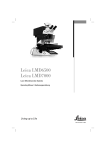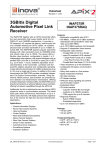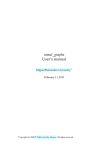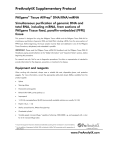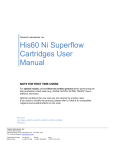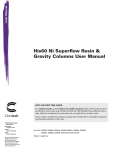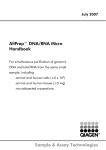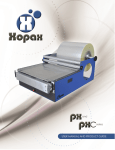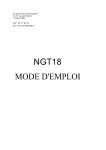Download Purification of total RNA, including miRNA, from
Transcript
PreAnalytiX Supplementary Protocol Purification of total RNA, including miRNA, from microdissected PAXgene® Tissue fixed, paraffin embedded (PFPE) and PAXgene Tissue fixed, cryoembedded (PFCE) tissues This protocol is for using the PAXgene Tissue miRNA Kit to purify total RNA, including miRNA, from PAXgene Tissue fixed, paraffin-embedded (PFPE) and PAXgene Tissue fixed, cryo-embedded (PFCE) tissues that have been manually or laser microdissected (LMD) from a slide. IMPORTANT: The tissue samples must be fixed and stabilized in PAXgene Tissue Containers. The PAXgene Tissue Container Product Circular includes information on tissue fixation and stabilization. For instructions on the preparation of PFCE tissue blocks, read the PreAnalytiX® Supplementary Protocol Cryo-embedding tissue specimens fixed and stabilized with the PAXgene Tissue System (PX14). To prepare sections from PFPE and PFCE tissue blocks for microdissection, follow instructions of the Supplementary Protocol Preparation of sections from PAXgene Tissue fixed, paraffin-embedded (PFPE) and PAXgene Tissue fixed, cryo-embedded (PFCE) tissue for manual or laser microdissection (PX20). Please read the PAXgene Tissue miRNA Kit Handbook, paying careful attention to the “Safety Information” and “Important Notes” sections, before beginning this procedure. For Research Use Only. Not for use in diagnostic procedures. No claim or representation is intended to provide information for the diagnosis, prevention, or treatment of a disease. Equipment and reagents When working with chemicals, always wear a suitable lab coat, disposable gloves, and protective goggles. For more information, consult the appropriate safety data sheets (SDSs), available from the product supplier. • RNase-free water • Ethanol (96–100%, purity grade p.a.) • Xylene • 14.3 M β-mercaptoethanol, β-ME (commercially available solutions are usually 14.3 M) • Variable-speed microcentrifuge* capable of attaining 1000–8000 x g, and equipped with a rotor for 2 ml microcentrifuge tubes • Microtome or cryostat* * Make sure that instruments have been checked and calibrated according to the manufacturer’s recommendations. www.PreAnalytiX.com • Shaker–incubator* capable of incubating at 45–80°C and shaking at ≥400 rpm, not exceeding 1400 rpm (e.g., Eppendorf® Thermomixer Compact)† • Vortex mixer* • Adhesion slides for manual microdissection (e.g., SuperFrost® Plus Slides, VWR® Cat. no. 6310108) or frame slides for laser microdissection, (e.g., PPS-membrane 25mm x 76 mm, Leica® Cat. no. 11505273) † • Laser Microdissection System* (e.g., Leica LMD6500 & LMD7000, Leica Microsystems)† • 1.5 ml safelock microcentrifuge tubes • 0.5 ml PCR tubes suitable for the dedicated LMD system (e.g. CORNING® AXYGEN® 0.5 ml Tube with Flat Cap, Cat. no. 10169-890† for Leica LMD6500 & LMD7000) Carrier RNA The PAXgene Tissue miRNA Kit contains poly-A RNA for use as carrier RNA. When added to lysates from microdissected tissue, the carrier RNA may improve the recovery of total RNA, including miRNA. Carrier RNA is not required when processing more than 5000 cells. The small amounts of poly-A RNA used as carrier RNA do not interfere with subsequent RT-PCR, even when oligo-dT is used as a primer for reverse transcription. Reverse-transcription reactions typically contain an excess of oligo-dT primers, and the small amounts of poly-A used as carrier RNA are insignificant in comparison. Total RNA purified using poly-A RNA as carrier RNA can be amplified with the QIAGEN® QuantiTect® Whole Transcriptome Kit, which uses a mix of random and oligo-dT primers. miRNA purified using poly-A RNA as carrier RNA can be amplified with the QIAGEN® miScript PCR System. Starting material Starting material for total RNA, including miRNA purification is a PFPE or PFCE tissue section mounted on an glass adhesion slide for manual microdissection (procedure A) or on a frame slide with a membrane for laser microdissection (procedure B). Sections must be prepared according to the Supplementary Protocol Preparation of sections from PAXgene Tissue fixed, paraffin-embedded (PFPE) and PAXgene Tissue fixed, cryo-embedded (PFCE) tissue for manual or Laser microdissection (LMD). Detach the microdissected specimen from the slide and transfer it to a dedicated collection device for direct purification of total RNA, including miRNA. IMPORTANT: The tissue source, the preanalytical workflow and the choice of materials used to make a PFPE and PFCE specimen significantly affect quality and quantity of isolated RNA. Furthermore, variability in quality and quantity of isolated RNA may be observed across species and tissue type. * Make sure that instruments have been checked and calibrated according to the manufacturer’s recommendations. † This is not a complete list of suppliers and does not include many important vendors of biological supplies. Total RNA, including miRNA from microdissected PFPE/PFCE tissue (PX19 Oct-15) page 2 of 1 Things to do before starting • If working with RNA for the first time, read “Appendix A: General Remarks on Handling RNA” in the PAXgene Tissue miRNA Kit Handbook. • Prepare 80% ethanol by mixing ethanol (96–100%, purity grade p.a.) and RNase-free water. • Set the temperature of the shaker–incubator to 45°C for PFPE tissues or to 56°C for PFCE tissues. • Buffer TM1 and Buffer TM2 (both concentrate and working solution) may form a precipitate during storage. If necessary, warm to 37°C to dissolve. • Buffer TM2 and Buffer TM3 are supplied as concentrates. Before using the buffers for the first time, add 3 volumes of isopropanol to Buffer TM2 and 4 volumes of ethanol (96–100%, purity grade p.a.) to Buffer TM3 to obtain working solutions. • Add β-Mercaptoethanol (β-ME) to Buffer TM1 before use. Add 10 µl β-ME per 1 ml Buffer TM1. Dispense in a fume hood and wear appropriate protective clothing. Buffer TM1 containing β-ME can be stored at room temperature (15–25°C) for up to 1 month. Pre-cool the Buffer TM1 on ice. • If using the RNase-Free DNase Set for the first time, prepare a DNase I stock solution. Dissolve the solid DNase I in 550 µl DNase resuspension buffer (RNase-free water) provided with the set. Do not vortex the reconstituted DNase I. DNase I is especially sensitive to physical denaturation. Mixing should only be carried out by gently inverting the tube. Reconstituted DNase I can be stored at 2–8°C for up to 6 weeks and at –15°C to –30°C for up to 6 months. • When processing <5000 cells, carrier RNA may be added to the lysate (see “Carrier RNA”, page 2). Before using carrier RNA for the first time, dissolve it (310 µg) in 1 ml RNase-free water. Store this stock solution at –20°C and use it to make fresh dilutions for each set of RNA preparations. The concentration of this stock solution is 310 ng/µl. Prepare a working solution of 4 ng/µl using Buffer TM1. Procedure A: Purification of total RNA, including miRNA, from manually microdissected PFPE and PFCE tissue In the procedure below, refers to PFPE tissue and ▲ refers to PFCE tissue. 1. Label the lid and the body of a 1.5 ml safelock microcentrifuge tube (not provided). Prepare a lysis mixture in the tube by pipetting 75 µl RNase-free water and 10 µl Proteinase K. Mix by gently flicking the tube, and centrifuge briefly (1–2 s at 500–1000 x g) to collect residual liquid from the sides of the tube. Note: When processing <5000 cells, add 20 ng of carrier RNA (5 µl of a 4 ng/µl solution) to the mixture. Prepare a dilution of carrier RNA as described in “Things to do before starting”. Total RNA, including miRNA from microdissected PFPE/PFCE tissue (PX19 Oct-15) page 3 of 1 2. Using a microtome or ▲ cryostat, make a tissue section of 6–12 µm thickness from a paraffin-embedded or ▲ cryo-embedded tissue block. Capture the tissue section on an RNase-free adhesion slide. 3. Remove embedding medium and stain (optional) according to the Supplementary Protocol Preparation of sections from PAXgene Tissue fixed, paraffin-embedded (PFPE) and PAXgene microdissection Tissue (LMD). fixed, Keep cryo-embedded freshly (PFCE) prepared tissue slides in for manual ice-cold or laser ethanol until microdissection. 4. For manual microdissection, remove the slide from the ethanol. Using an absorbent sheet, wipe away the liquid on the slide that surrounds the tissue section. Note: Tissue areas of interest can be isolated by scratching away other tissue parts with a scalpel blade or cell scraper. Remove tissue portions from the slide immediately after taking the section out of the ethanol. Avoid completely drying the section because this makes it harder to dissolve the tissue from the slide. 5. Place the slide on a horizontal working plate, and overlay the section with 85 µl ice-cold Buffer TM1. Make sure that the whole section is covered. Note: Work quickly. We recommend using a dark underlay as a work surface to make it easier to see the tissue. The volume of Buffer TM1 needed depends on the tissue surface area. 6. Detach the tissue on the slide by pipetting the lysis mixture up and down. Transfer the tissue and all liquid to the labeled 1.5 ml safelock microcentrifuge tube from step 1 and mix by vortexing for 5 s. Note: If the tissue does not dissolve easily, use the pipet tip to scrape the tissue from the slide. 7. Incubate the tissue on a shaker–incubator for 15 min at 1400 rpm and 45°C or ▲ 56°C. 8. After incubation, centrifuge briefly (1–2 s at 500–1000 x g) to remove drops from the tube lid. 9. Add 240 µl ethanol (96–100%, purity grade p.a.). Mix by vortexing for 5 s and centrifuge briefly (1–2 s at 500–1000 x g) to remove drops from the tube lid. 10. Pipet the sample, including any precipitate that may have formed, into a PAXgene RNA MinElute spin column (red) positioned in a 2 ml processing tube. Centrifuge for 15 s at 8000 x g. Place the spin column in a new 2 ml processing tube and discard the old processing tube containing the flow-through. 11. Continue with step 15 of the protocol “Purification of Total RNA, Including miRNA, from Sections of PFPE Tissue” in the PAXgene Tissue miRNA Kit Handbook (page 19). Note: The elution volume can vary between 14–40 µl and strongly depends on the area and number of microdissected cells. Low input requires lower elution volumes for high concentrations of RNA. Furthermore, repeated elution steps increase the overall total RNA yield of a sample. Total RNA, including miRNA from microdissected PFPE/PFCE tissue (PX19 Oct-15) page 4 of 1 Procedure B: Purification of total RNA, including miRNA, from laser microdissected (LMD) PFPE and PFCE tissue 1. Using a microtome or ▲ cryostat, make a tissue section of 6–12 µm thickness from a paraffin-embedded or ▲ cryo-embedded tissue block. Capture the tissue section on a frame slide with membrane for laser microdissection. 2. Remove embedding medium and stain (optional) according to the Supplementary Protocol Preparation of sections from PAXgene Tissue fixed, paraffin-embedded (PFPE) and PAXgene Tissue fixed, cryo-embedded (PFCE) tissue for manual or laser microdissection (LMD). Keep freshly prepared slides in ice-cold ethanol until laser microdissection. 3. Using a Laser Microdissection System, dissect a tissue area of ≥5000 µm2 (≥50 cells) from the PFPE or PFCE LMD slide. Note: ≤50 cells may require pre-amplification of cDNA for downstream applications (use, for example, the QIAGEN REPLI-g® WTA Single Cell Kit). 4. Collect cells directly into a dedicated collection tube filled with 15 µl Buffer TM1 (use, for example, the cap of a 0.5 ml PCR tube when using a Leica LMD system). Note: If not possible, add Buffer TM1 immediately after collecting the cells. Make sure to add βME to Buffer TM1 before use (see “Things to do before starting”). 5. Add 60 µl Buffer TM1. Mix by vortexing for 30 s, and centrifuge briefly (1–2 s at 500– 1000 x g) to remove drops from the tube lid. Note: The volume of Buffer TM1 depends on the collection vessel used for microdissection, but should not exceed 80 µl. Lysates in Buffer TM1 can be frozen at –80°C, however, freezing may impact RNA yield when a low number of cells is used. Thaw frozen lysates on ice and proceed with step 6. 6. If processing <5000 cells, 20 ng carrier RNA (5 µl of a 4 ng/µl solution) may be added to the lysate. Prepare the carrier RNA as described in “Things to do before starting”. 7. Add 75 µl RNase-free water and 10 µl Proteinase K and mix by vortexing for 5 s. Note: Do not mix Buffer TM1 and Proteinase K before adding them to the sample. 8. Incubate on a shaker–incubator for 15 min at 45°C or ▲ 56°C and 1400 rpm. After incubation, centrifuge briefly (1–2 s at 500–1000 x g) to remove drops from the tube lid. 9. Add 240 µl ethanol. Mix by vortexing for 5 s and centrifuge briefly (1–2 s at 500–1000 x g) to remove drops from the tube lid. 10. Pipet the sample, including any precipitate that may have formed, into a PAXgene RNA MinElute spin column (red) positioned in a 2 ml processing tube. Centrifuge for 15 s at 8000 x g. Place the spin column in a new 2 ml processing tube and discard the old processing tube containing the flow-through. Total RNA, including miRNA from microdissected PFPE/PFCE tissue (PX19 Oct-15) page 5 of 1 11. Continue with the wash of step 15 of the protocol “Purification of Total RNA, including miRNA, from sections of PFPE tissue” in the PAXgene Tissue miRNA Kit Handbook (page 19). Note: The elution volume can vary between 14–40 µl and strongly depends on the area and number of microdissected cells. Low input requires lower elution volumes for high concentrations of RNA. Furthermore, repeated elution steps increase the overall total RNA yield of a sample. For up-to-date licensing information and product-specific disclaimers, see the respective PreAnalytiX or QIAGEN kit handbook or user manual. Handbooks and user manuals are available at www.qiagen.com and www.preanalytix.com or can be requested from QIAGEN Technical Services or your local distributor. Safety data sheets (SDS) for any QIAGEN or PreAnalytiX product can be downloaded from www.qiagen.com/safety. ® ® Trademarks: PAXgene®, PreAnalytiX® (PreAnalytiX GmbH); QIAGEN®, QuantiTect , REPLI-g (QIAGEN Group); CORNING®, AXYGEN® (Corning Inc.); Eppendorf® (Eppendorf AG); Leica® (Leica Microsystems IR GmbH); ® SuperFrost , VWR® (VWR International LLC). Registered names, trademarks, etc. used in this document, even when not specifically marked as such, are not to be considered unprotected by law. PX19 © 2015 PreAnalytiX, all rights reserved. www.PreAnalytiX.com






